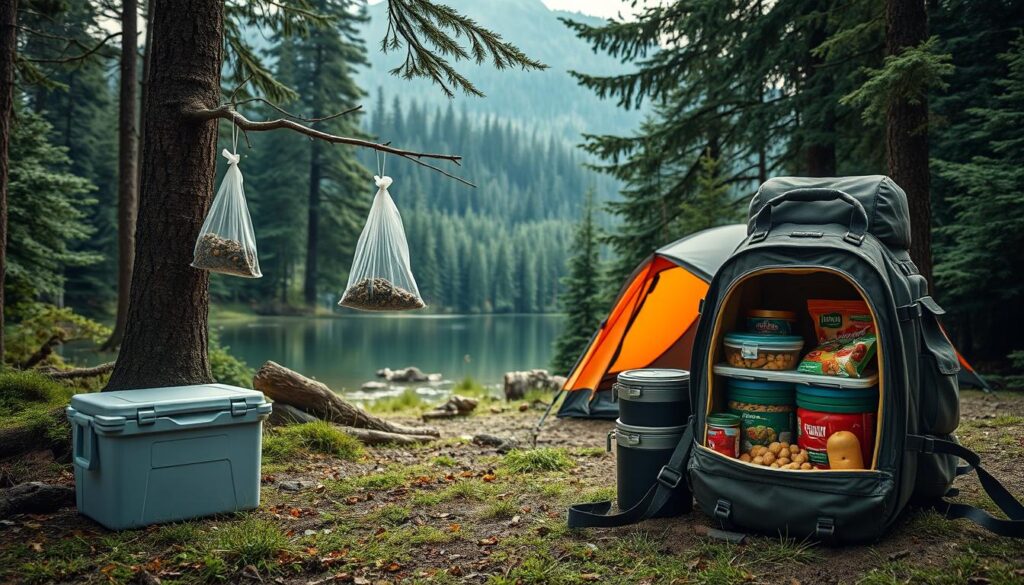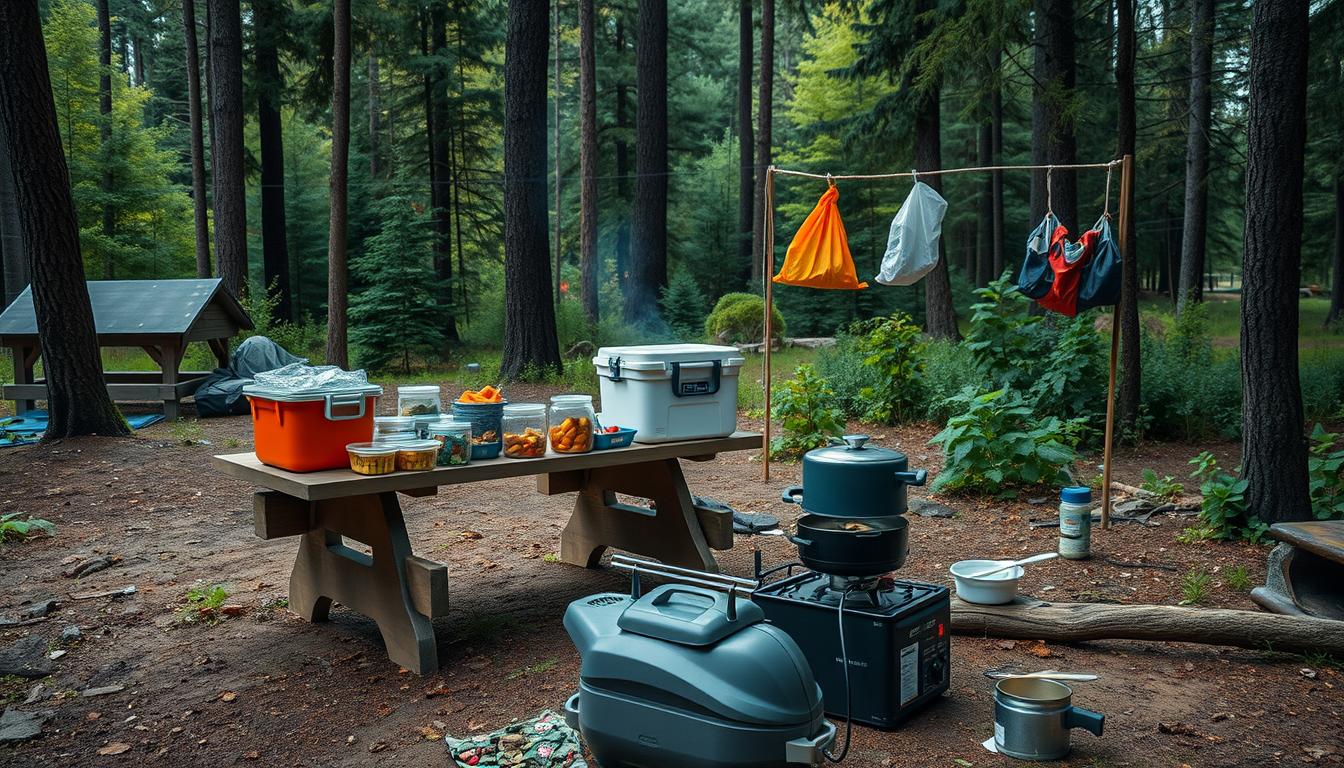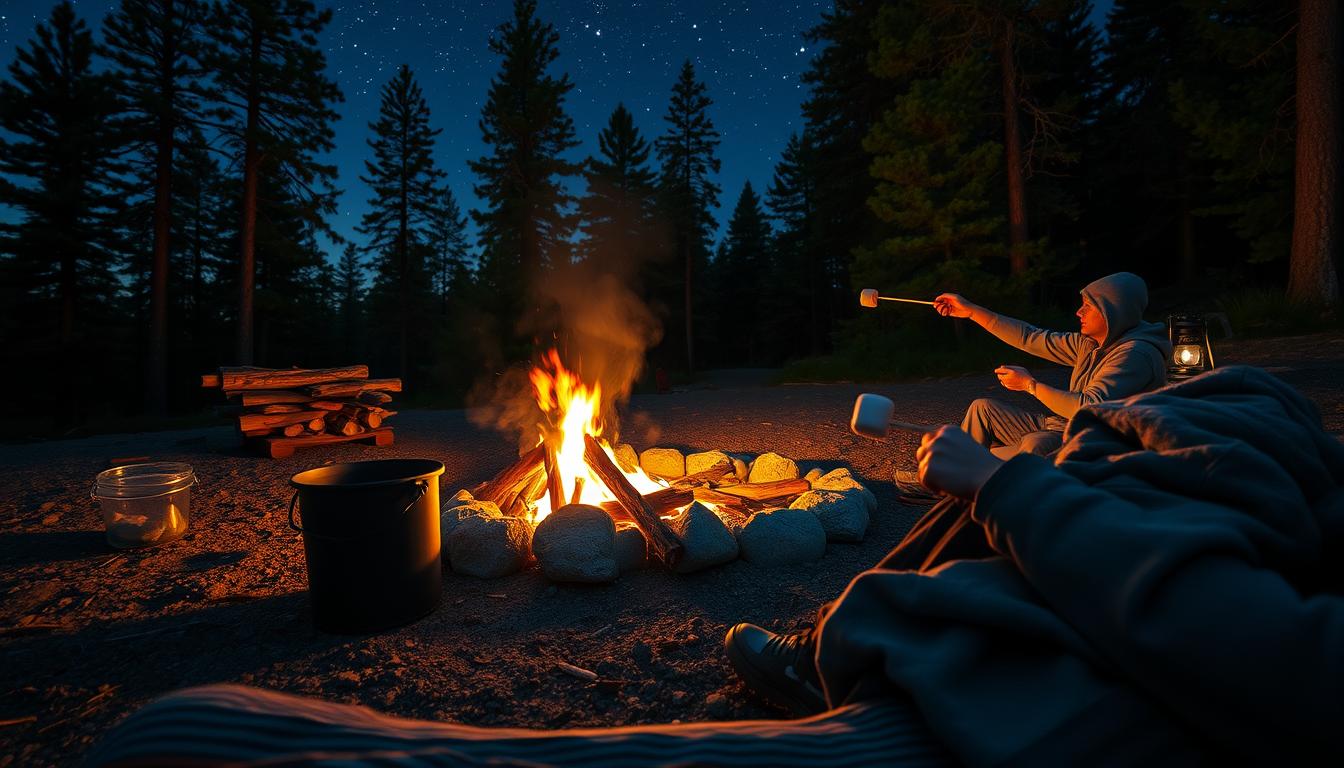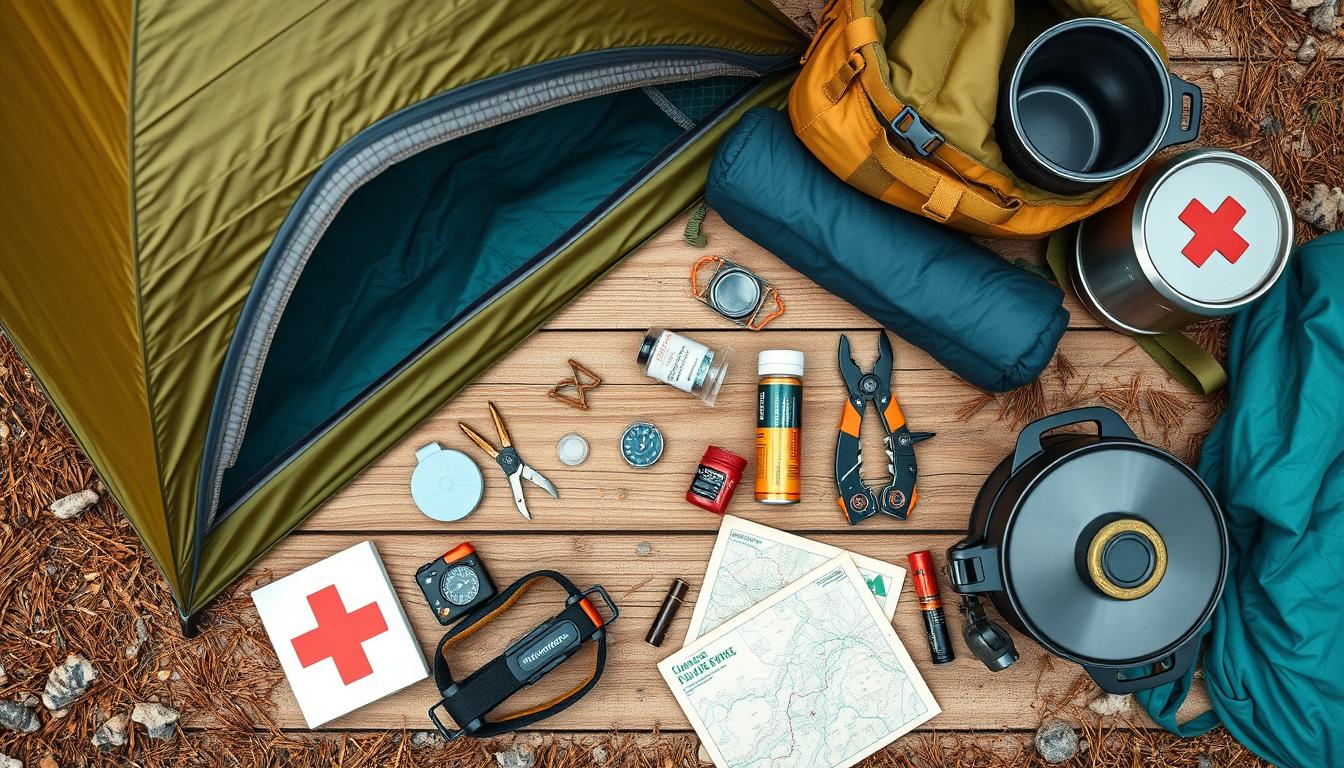When I plan my next camping trip, food safety is top of mind. It’s important to know how to keep food away from animals to avoid trouble. The Centers for Disease Control and Prevention (CDC) says good food safety habits keep me healthy and animals away.
Learning about local wildlife and following food safety tips helps me enjoy the outdoors safely. This way, I can focus on the fun without worrying about animals.
Key Takeaways
- Understanding food safety is critical for a safe camping experience.
- Improper food storage can lead to wildlife encounters.
- Follow CDC guidelines to protect your health while exploring nature.
- Study local wildlife behaviors to mitigate risks.
- Implement practical camping food safety tips to enjoy your adventure fully.
Understanding the Importance of Food Safety While Camping
Food safety is crucial when camping. Many campers don’t realize the risks of storing food outside. Animals like bears, raccoons, and squirrels are attracted to human food. This can lead to dangerous situations if food isn’t stored right.
It’s important to follow camping food safety tips to have a safe and fun trip. The National Park Service stresses the need to keep food stored properly. This helps avoid wildlife encounters and keeps everyone safe.
To prevent wildlife from stealing food, we need to store it wisely. Each camper should take steps to protect their food and the wildlife. By being aware and taking action, we can make outdoor adventures safe and enjoyable.
Choosing the Right Campsite
Choosing the right campsite is key for keeping food safe while camping. The location can affect your safety and fun, especially with wildlife nearby. Paying attention to certain factors made a big difference in how I stored food.
Factors to Consider When Selecting a Campsite
Being close to water sources is tempting but can attract animals. Higher areas often have fewer animal encounters. Also, look for signs of wildlife like tracks or droppings. These tips help protect your food better.
Avoiding Sites Near Wildlife Trails
Staying away from wildlife trails is crucial. Animals like bears and raccoons use these trails, increasing encounter risks. The U.S. Forest Service advises avoiding these areas. Choosing a different spot has kept my food and me safe. For more tips, see this guide on keeping animals away while camping.

How to Keep Your Food Safe from Animals While Camping
Keeping food safe from animals while camping is key for a great outdoor trip. First, learn about the local wildlife. Knowing about animals like bears and raccoons helps plan how to keep food safe.
Using the right gear is important. Bear canisters are great for securing food in bear areas. For car camping, a bear-proof cooler helps keep animals away. Hanging food bags 10 to 15 feet up in a tree is also effective.
When cooking or eating outside, use methods that reduce scents and crumbs. Cooking away from where you sleep keeps animals away. Also, don’t leave food scraps to avoid attracting smaller animals.
For more tips on keeping food safe, check this useful resource. Using these strategies makes camping safer and more enjoyable.
Proper Food Storage Techniques
Securing food from wildlife while camping is crucial. Proper food storage techniques greatly reduce wildlife encounters. Bear canisters are a key tool for keeping food safe. They are designed to withstand animal attempts, giving campers peace of mind.
Utilizing Bear Canisters
Bear canisters are a top choice for storing food. Their hard exterior makes it hard for wildlife to get in. Many parks require them in bear habitats, showing their effectiveness.
Using bear canisters saves my food and reduces stress about wildlife. It’s a simple yet effective way to keep food safe.
Choosing Wildlife-Proof Containers
Choosing the right containers is also important. Brands like ULA and Sea to Summit offer strong options. These containers are made from durable materials that resist gnawing and seal well.
Investing in reliable containers makes securing food easier. It adds safety to camping trips.
Storing Food at the Correct Height
Knowing the wildlife in the area helps me choose the right food storage height. Storing food at least 10 feet off the ground keeps larger animals away. This smart strategy is key to safe camping.
Best Practices for Cooking and Eating Outdoors
When I go camping, I focus on safe cooking and eating. These steps help keep animals away from our food. I make sure to cook and eat at the right times and clean up well.
Timing Your Meals Wisely
Choosing the right time to cook and eat is key. I cook and eat in the early evening or after dusk. This helps avoid attracting animals, as they are more active at dawn and dusk.
Cleaning Up Thoroughly After Eating
Cleaning up after meals is very important. I do the following:
- Dispose of all food scraps and trash properly.
- Wash dishes in a designated area away from the campsite.
- Store leftover food in wildlife-proof containers.
Following these practices makes my camping trips safer. It also reduces the chance of wildlife encounters.
Preventing Wildlife Food Theft
When camping, it’s key to stop wildlife from stealing food. This keeps you safe and makes your trip better. Knowing how to protect your food is important. It helps you understand how to keep it safe from local animals.
Strategies for Deterrence
There are many ways to keep your food safe. Here are some methods that work:
- Noise-making devices: Simple tools like bells or wind chimes can scare animals away from your campsite.
- Barriers: Physical barriers like fencing can add extra protection for where you store your food.
- Bright lights: Motion-activated lights can scare away animals that come out at night.
Understanding Animal Behavior
Knowing how animals behave is crucial when planning meals and storage. Here are some important points:
- Animals are more active at dusk and dawn. Avoiding mealtime during these hours helps keep them away.
- Knowing what local animals like to eat helps you store food better.
- Keeping your campsite clean greatly reduces the chance of animal encounters.

Bear Safety Camping Tips
When camping in areas where bears are common, it’s key to know your surroundings. Spotting bear signs helps you gauge risks and enjoy the outdoors safely. Keeping your food safe from animals is crucial, especially when bears are around.
Recognizing Bear Signs
Spotting bear signs can greatly improve your safety. Look for:
- Paw prints in mud or dirt, which can indicate recent activity.
- Digs in the ground, often where bears search for food.
- Scat, which provides clues about the bear’s diet and health.
Being alert to these signs helps me choose a safer campsite. If I see them, I might need to move or take extra steps to protect my food.
Carrying Bear Spray
Carrying bear spray is a must in bear country. It’s a strong deterrent that can stop an aggressive bear. Make sure your bear spray is:
- Always with you while hiking or camping.
- Stored in a holster or with a safety clip to avoid accidental discharge.
- Well-maintained and within its expiration date.
Bear safety tips stress the need to know how to use bear spray correctly. Practicing with it prepares you for emergencies, making you more confident in critical moments.
Securing Food from Wildlife While Camping
Keeping food safe from wildlife is key to a safe camping trip. Hanging food bags is a simple yet effective way to do this. I hang food 10 to 15 feet off the ground and 4 feet from a tree. This keeps bears and raccoons away from my food.
Hanging Food Bags
I use a strong rope to hang my food bags. It’s important to pick a sturdy branch and use odor-proof bags. Hanging food bags properly keeps my food safe and enhances my camping experience.
Using Lockable Containers
I also use lockable containers from brands like Coghlan’s and BearVault. These containers add extra security against wildlife. Their strong designs and locks keep animals out. Using these containers makes me feel secure, allowing me to enjoy nature without worry.





Leave a Reply